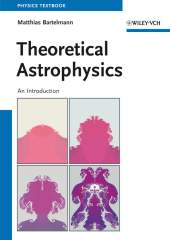 Neuerscheinungen 2013Stand: 2020-01-07 |
Schnellsuche
ISBN/Stichwort/Autor
|
Herderstraße 10
10625 Berlin
Tel.: 030 315 714 16
Fax 030 315 714 14
info@buchspektrum.de |

Matthias Bartelmann
Theoretical Astrophysics
An Introduction
2013. XX, 320 S. 71 SW-Abb., 6 Farbabb. 240 mm
Verlag/Jahr: WILEY-VCH 2013
ISBN: 3-527-41004-X (352741004X)
Neue ISBN: 978-3-527-41004-0 (9783527410040)
Preis und Lieferzeit: Bitte klicken
Dieses Lehrbuch bietet eine knappe, aber dennoch umfassende Einführung in die zentralen Themen der modernen Astrophysik.
Das Buch ist modular aufgebaut und der Autor erklärt reichlich illustriert fundamentale physikalische Methoden und Prinzipien in der Astronomie. Er hilft beim Verständnis und der Beschreibung einer großen Zahl astrophysikalischer Phänomene und Prozesse.
Das Buch richtet sich an Masterstudenten und Dozenten, die Kurse in theoretischer Astrophysik oder zu anspruchsvolleren Themen moderner Astronomie geben. Mit seinen vielen Beispielen und Übungen kann das Werk auch als Nachschlagewerk und Einstieg für erfahrenere Forscher dienen, die ihr Wissen über die physikalischen Prozesse auffrischen wollen, die das Verhalten und das Entstehen astronomischer Objekte bestimmen.
This book provides a comprehensive overview and introduces the basic theoretical concepts relevant for modern astrophysics. The book is structured in a modular way and can also be used by other researchers who want to refresh their memory of theoretical aspects in astrophysics.
Beginning from first principles and adopting a modular structure, this book develops the fundamental physical methods needed to describe and understand a wide range of seemingly very diverse astrophysical phenomena and processes. For example, the discussion of radiation processes including their spectra is based on Larmor´s equation and extended by the photon picture and the internal dynamics of radiating quantum systems, leading to the shapes of spectral lines and the ideas of radiation transport. Hydrodynamics begins with the concept of phase-space distribution functions and Boltzmann´s equation and develops ideal, viscous and magneto-hydrodynamics all from the vanishing divergence of an energy-momentum tensor, opening a natural extension towards relativistic hydrodynamics. Linear stability analysis is introduced and used as a common and versatile tool throughout the book.
Aimed at students at graduate level, lecturers teaching courses in theoretical astrophysics or advanced topics in modern astronomy, this book with its abundant examples and exercises also serves as a reference and an entry point for more advanced researchers wanting to update their knowledge of the physical processes that govern the behavior and evolution of astronomical objects.
1. Theoretical Foundations
2. Radiation Processes
3. Hydrodynamics
4. Plasma Physics and Magnetohydrodynamics
5. Stellar Dynamics


